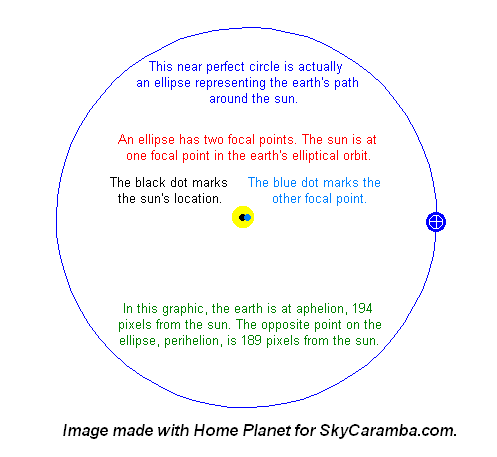Astronomy blog for the week ending July 2, 2011
Some people in the northern hemisphere have trouble believing it, but when summer’s starting to get hot Earth is farthest from the sun. The earth’s distance from the sun is a little different every day because Earth doesn’t go around the sun in a perfect circle (although it comes close).
The path a planet makes around its parent star is an ellipse. You might call it an oval, but professional mathematicians say only some ovals are ellipses. They like to be as accurate as they can. I think that’s good practice, so ellipse it is.
There are two focal points inside an ellipse. Take any point along the ellipse and measure how far it is from each focal point. Add those distances to the distance between each focal point. Then make the same measurements and additions for any other point on the ellipse. You’ll get the same answer.
An easy way to draw an ellipse is to stick two pins through a piece of paper and put a string that doesn’t stretch around them. Use a pencil to pull the string into a taut triangle. Then, keeping the string taught, go around the two pins with the pencil as though you’re drawing a circle with a compass. Your writing utensil will follow the path of an ellipse with the pins marking the two focal points.
With that image in your mind, think of the pencil as marking the path of a planet around the sun and one of the focal points marking the position of the sun. You can see that on one side of the ellipse, the pencil is closest to that focal point. And on the opposite side, the pencil is farthest. That’s how planets orbit the sun, being closest on one side of the orbit and farthest on the other.
The point farthest from the sun is called aphelion. Earth will be at aphelion July 4, 2011 at 14:54 UT. Earth will be 94.5 million miles or 152.1 million kilometers from the sun. Almost exactly six months later, Earth will be closest to the sun. That’s called perihelion.
Some people have trouble believing that in early July the earth can be farthest from the sun. Everybody knows that, at least in the northern hemisphere, it’s getting hot in July. Since the sun is hot, it seems reasonable that the sun should be closer. They’re forgetting it’s winter at the same time in the southern hemisphere.
Sure, the sun’s distance affects how much of its energy reaches Earth and heats it up—overall. A bigger influence on the weather is how directly the solar energy reaches different parts of the planet. During a northern summer, the northern hemisphere is tilted toward the sun. The more directly the sun’s light can shine on a surface the warmer that surface becomes.
It’s a good thing Earth’s orbit is almost a perfect circle. Otherwise, the earth-sun distance would make a big difference. I think the seasonal temperature differences are enough.
